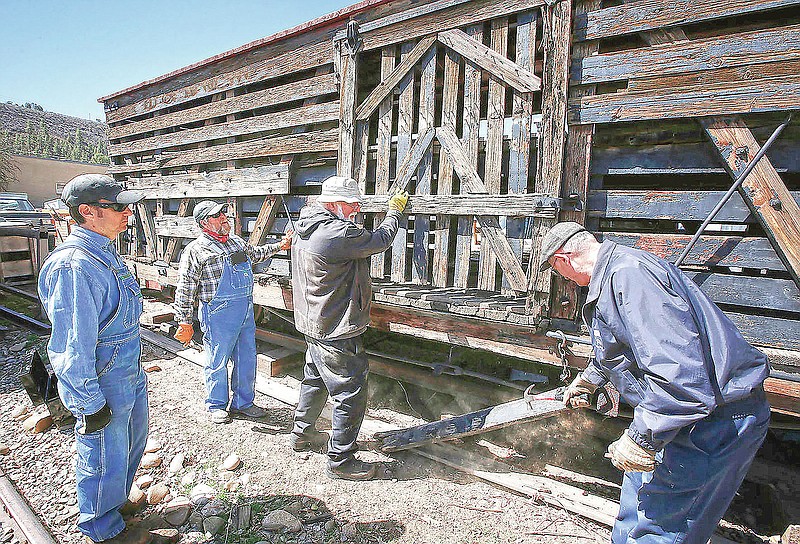DOLORES, Colo. -- Before the Galloping Goose No. 5 rail car carried passengers and mail to and from Dolores in the 1930s and 40s, freight trains and steam locomotives dominated the historic railroad town.
Showcasing the bustling freight train commerce from 1891 to the 1930s on the Rio Grande Southern Railroad is the focus of a new effort by the Galloping Goose Historical Society Museum in Dolores.
The museum has acquired five historic, narrow-gauge freight cars and is restoring them for display. They will be positioned on two tracks behind the museum in Flanders Park.
Dolores is known for the beloved Galloping Goose No. 5, which lives in front of the museum and runs today on host railroads in Durango and Chama, N.M.
But the Goose service from 1933 to 1951 through Dolores was just a part of the 60-year history of the Rio Grande Southern Railroad in town that began in 1891, said Joe Becker, president of the Galloping Goose Historical Society.
"The railroad was so much more. The freight trains were the economic engine of this part of the country. They provided the most dependable transportation service," he said.
Freight trains transported lumber from large producing local sawmills in the Dolores area and hauled livestock, coal and mining ore.
Specialized refrigerated cars carried away apple harvests from orchards that filled the Dolores Valley. Ice blocks would be positioned in hatches on both ends of the car. As the train moved, air would pass over the ice and keep the produce cool.
"Because of the railroad service, Dolores was a real hub of economic activity. By displaying these cars, we want to help bring that time back to life so the public can appreciate it," said museum volunteer and railroad enthusiast Bill Wolf.
The museum traded a stash of rail line for a historic drop bottom gondola from the Durango and Silverton Narrow Gauge Railroad, which was reducing inventory.
Three other freight cars were obtained from private owners by trading rail line. And the museum swapped Coach 256 for a boxcar from a private owner, because the coach was too expensive to restore.
"We learned it takes two truckloads of rail line to buy one freight car," Becker said. The museum still has a good supply of rail, he said.
Restoration of the freight cars is cosmetic and is done to stabilize them for public display, not to put them back in service.
Once the cars are set up, museum visitors will be able to walk through them from a platform behind the museum.
Boxcar 368 likely hauled mining ore or equipment. Graffiti is carved into the wood that spells out "Tom Boy," a historic mine in the Telluride area. The date appears to be Jan. 7, 1921.
Valuable mine ore stored in gunny sacks would be transported in boxcars because the car could be locked, Wolf said.
Other graffiti in the car appears to be the name of a mine or rail worker.
Double-decker stock car No. 5543 was built in 1904 by the American Car and Foundry Co. and hauled sheep, cattle and hogs.
Sheep would have been loaded in the top and bottom of the car. The middle deck would be removed to haul cattle. A layer of sand on the floor helped animals keep their footing during the train ride. The train would take the livestock to markets or to slaughterhouses in big cities.
The Rio Grande Southern Railroad through Dolores ran stock trains in spring and fall, hauling livestock to mountain pasture then later to winter pasture.
The trains consisted of eight to 10 stock cars, a boxcar carrying feed and supplies and a caboose carrying railroad crew and drovers who managed the livestock, according to the museum. Two locomotives were assigned for power because of the steep grades into the San Juan Mountains.
Dolores had a livestock pen in town on Third Street and another just outside of town in Lost Canyon.
The gondola-style freight cars hauled gravel, coal or coke, which is processed coal used for steel making.
The coal was to feed tenders of locomotives and sold to the community for heating. High-side gondolas were unloaded by hand and shovel. Drop-bottom gondolas were emptied from doors underneath.
According to the museum, gondola No. 842 was built by American Car Foundry Co. in 1904 for the Denver and Rio Grande Western Railroad. It was used to haul coke from Durango to steel mills in Pueblo.
Drop-bottom gondolas were an everyday sight in Dolores, Becker said.
The cars are still in use on the Cumbres & Toltec Railroad and the Durango and Silverton Narrow Gauge Railroad to haul track ballast and gravel for track maintenance. The car was used until narrow gauge freight service on Denver and Rio Grande Western Railroad stopped in 1967. The car later became part of the Durango and Silverton railroad's freight car roster and was obtained by the Galloping Goose Historical Museum in 2019.
Ken Vance, who owns an equipment yard near the Galloping Goose museum, agreed to store the rail cars while they undergo restoration. After completed and the tracks are laid, the 27,000-pound freight cars will be moved to the museum for display. The goal is to have the rails installed this year and the freight car display in place by next year.
During a recent tour of the freight cars, volunteers removed sliding doors on the stock cars, which will be replaced replicas built by volunteers. Roofs on both stock cars also were replaced.
The box car was freshly painted in original brown, and its doors will be repaired.
"The main goal is to generate more interest in the museum and help the public understand how important the railroad was to opening this area to development," Wolf said. "The original purpose of the railroad was to service the mines, but in reality, it served the community in many more ways and brought prosperity to the region."



